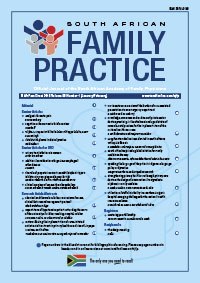Clinical overview of venous thromboembolism
Keywords:
anticoagulants, deep vein thrombosis, DVT, embolus, NOAC, PE, pulmonary embolism, thromboprophylaxis, thrombus, venous thromboembolism, Virchow’s triad, VTE
Abstract
Venous thromboembolism (VTE) encompasses two vascular conditions that are of significant importance, namely deep vein thrombosis (DVT) and pulmonary embolism (PE). DVT is also the most common cause of PE. Medical and surgical patients, and individuals who are at increased risk of developing VTE through a variety of factors, require adequate thromboprophylaxis. Primary and secondary prevention, as well as the definitive treatment of VTE, are accomplished through the use of a variety of anticoagulant drugs. This article attempts to provide an overview of VTE, and its prevention and treatment.
Section
Review Articles
By submitting manuscripts to SAFP, authors of original articles are assigning copyright to the South African Academy of Family Physicians. Copyright of review articles are assigned to the Publisher, Medpharm Publications (Pty) Ltd, unless otherwise specified. Authors may use their own work after publication without written permission, provided they acknowledge the original source. Individuals and academic institutions may freely copy and distribute articles published in SAFP for educational and research purposes without obtaining permission.

